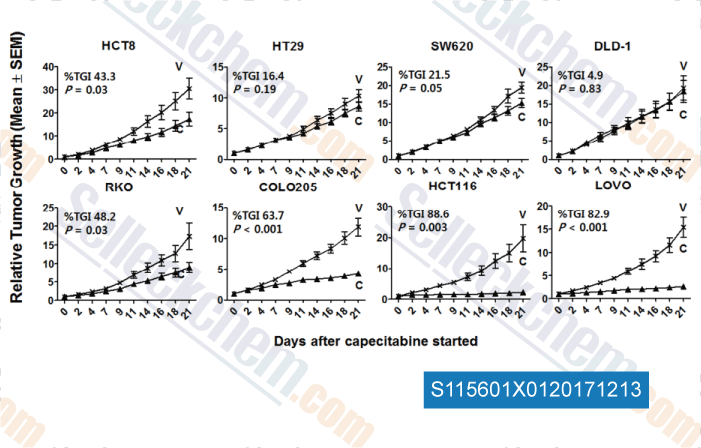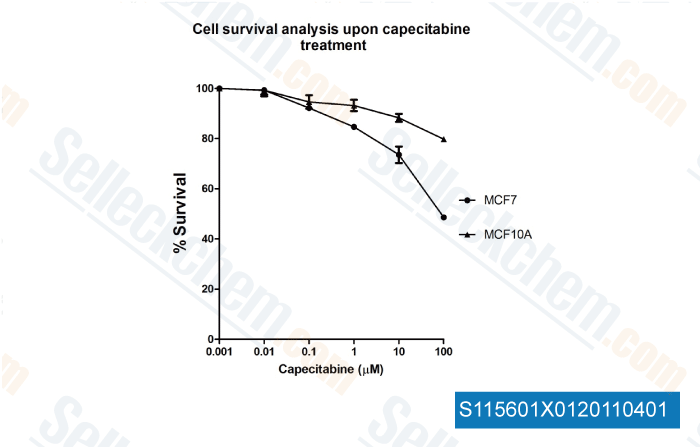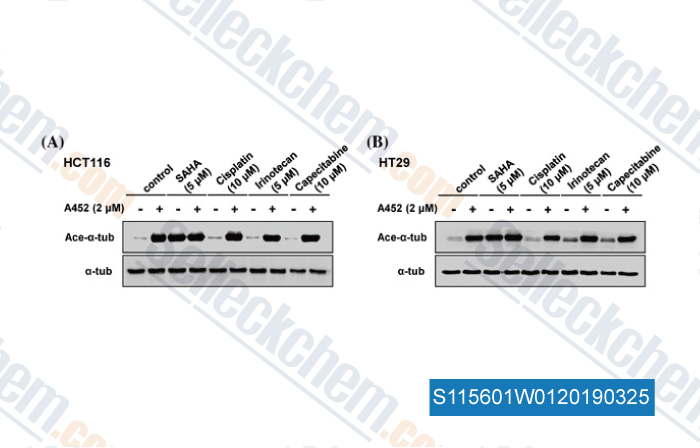|
Toll Free: (877) 796-6397 -- USA and Canada only -- |
Fax: +1-832-582-8590 Orders: +1-832-582-8158 |
Tech Support: +1-832-582-8158 Ext:3 Please provide your Order Number in the email. |
Technical Data
| Formula | C15H22FN3O6 |
||||||
| Molecular Weight | 359.35 | CAS No. | 154361-50-9 | ||||
| Solubility (25°C)* | In vitro | DMSO | 72 mg/mL (200.36 mM) | ||||
| Ethanol | 72 mg/mL (200.36 mM) | ||||||
| Water | 6 mg/mL (16.69 mM) | ||||||
| In vivo (Add solvents to the product individually and in order) |
|
||||||
|
* <1 mg/ml means slightly soluble or insoluble. * Please note that Selleck tests the solubility of all compounds in-house, and the actual solubility may differ slightly from published values. This is normal and is due to slight batch-to-batch variations. * Room temperature shipping (Stability testing shows this product can be shipped without any cooling measures.) |
|||||||
Preparing Stock Solutions
Biological Activity
| Description | Capecitabine is a tumor-selective fluoropyrimidine carbamate, which achieves higher intratumoral 5-FU level with lower toxicity than 5-FU. This compound treatment of HCT-15 cells causes condensation of DNA and induces apoptosis. | |
|---|---|---|
| Targets |
|
|
| In vitro | Both LS174T WT and LS174T-c2 cells show significantly greater sensitivity to Capecitabine when cultivated in the same plates as HepG2 hepatoma with IC50 values of 890 and 630 μM in LS174T WT alone and cultivated with HepG2, respectively. In addition, for the LS174T-C2 subline, the IC50 falls from 330 ± 4 down to 89 ± 6 μm when cultivated in the same plates as hepatoma cells. Furthermore, this compound induces apoptosis in a Fas-dependent manner, and shows a 7-fold higher cytotoxicity and markedly stronger apoptotic potential in thymidine phosphorylase (TP)-transfected LS174T-c2 cells. [1] | |
| In vivo | In the human cancer xenograft models studied, Capecitabine is more effective in a wider dose range and has a broader spectrum of antitumor activity than 5-FU, UFT or its intermediate metabolite 5'-DFUR, which can be correlated with tumor dThdPase levels. [2] This compound inhibits tumor growth and metastatic recurrence after resection of human hepatocellular carcinoma (HCC) in highly metastatic nude mice model which is attributed to the high expression of platelet-derived endothelial cell growth factor in tumors. [3] | |
| Features | A tumor-selective fluoropyrimidine carbamate. |
Protocol (from reference)
| Cell Assay:[1] |
|
|---|---|
| Animal Study:[2] |
|
References
|
Customer Product Validation

-
, , Cancer Res, 2017, 77(24):7120-7130

-
, , Dr. Helen Sadik of Johns Hopkins University

-
Data from [ , , Carcinogenesis, 2018, 39(1):72-83 ]

-
Data from [ , , Mol Carcinog, 2018, 57(10):1383-1395 ]
Selleck's Capecitabine Has Been Cited by 29 Publications
| A pancreatic cancer organoid biobank links multi-omics signatures to therapeutic response and clinical evaluation of statin combination therapy [ Cell Stem Cell, 2025, S1934-5909(25)00265-6] | PubMed: 40812300 |
| Zinc finger protein 831 promotes apoptosis and enhances chemosensitivity in breast cancer by acting as a novel transcriptional repressor targeting the STAT3/Bcl2 signaling pathway [ Genes Dis, 2024, 11(1):430-448] | PubMed: 37588209 |
| Patient-derived rhabdomyosarcoma cells recapitulate the genetic and transcriptomic landscapes of primary tumors [ iScience, 2024, 27(10):110862] | PubMed: 39319271 |
| Fisetin and/or capecitabine causes changes in apoptosis pathways in capecitabine-resistant colorectal cancer cell lines [ Naunyn Schmiedebergs Arch Pharmacol, 2024, 397(10):7913-7926] | PubMed: 38748229 |
| Fisetin and/or capecitabine causes changes in apoptosis pathways in capecitabine-resistant colorectal cancer cell lines [ Naunyn Schmiedebergs Arch Pharmacol, 2024, 10.1007/s00210-024-03145-0] | PubMed: 38748229 |
| Establishment and Characterization of NCC-PMP1-C1: A Novel Patient-Derived Cell Line of Metastatic Pseudomyxoma Peritonei [ J Pers Med, 2022, 12(2)258] | PubMed: 35207746 |
| Establishment and characterization of NCC-UPS4-C1: a novel cell line of undifferentiated pleomorphic sarcoma from a patient with Li-Fraumeni syndrome [ Hum Cell, 2022, 10.1007/s13577-022-00671-y] | PubMed: 35118583 |
| Multifocal Organoid Capturing of Colon Cancer Reveals Pervasive Intratumoral Heterogenous Drug Responses [ Adv Sci (Weinh), 2021, e2103360] | PubMed: 34918496 |
| Establishment and characterization of novel patient-derived cell lines from giant cell tumor of bone [ Hum Cell, 2021, 10.1007/s13577-021-00579-z] | PubMed: 34304386 |
| Establishment and characterization of the NCC-GCTB4-C1 cell line: a novel patient-derived cell line from giant cell tumor of bone [ Hum Cell, 2021, 10.1007/s13577-021-00639-4] | PubMed: 34731453 |
RETURN POLICY
Selleck Chemical’s Unconditional Return Policy ensures a smooth online shopping experience for our customers. If you are in any way unsatisfied with your purchase, you may return any item(s) within 7 days of receiving it. In the event of product quality issues, either protocol related or product related problems, you may return any item(s) within 365 days from the original purchase date. Please follow the instructions below when returning products.
SHIPPING AND STORAGE
Selleck products are transported at room temperature. If you receive the product at room temperature, please rest assured, the Selleck Quality Inspection Department has conducted experiments to verify that the normal temperature placement of one month will not affect the biological activity of powder products. After collecting, please store the product according to the requirements described in the datasheet. Most Selleck products are stable under the recommended conditions.
NOT FOR HUMAN, VETERINARY DIAGNOSTIC OR THERAPEUTIC USE.
